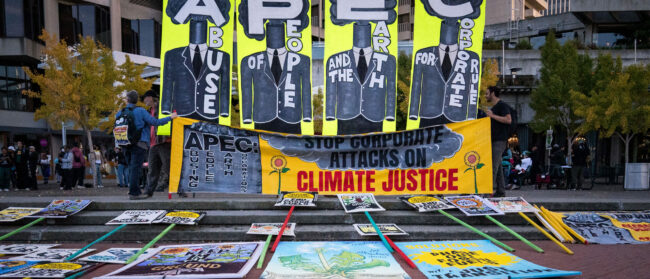Squatting on a lawn chair in front of her shop near Phnom Penh’s railway station, rice-vendor Ev does not seem too concerned by the worst drought to hit Southeast Asia in more than 50 years. Poker-faced, she brushes aside suggestions that the dry conditions could continue to put the nation’s vulnerable rice industry at risk – a crisis the Cambodian government has done little to address.
“I never think about government support,” she said. “The way I do my business only depends on supply and demand.”
For the Kingdom’s struggling rice-export industry, though, the challenges of the future are harder to ignore.
Despite a rise in global rice prices of as much as 16%, Cambodia’s fragile rice sector is in no position to take advantage of the high price its crop could command.
Despite recent downfalls, the effects of the worst drought in half a century still bite. There is simply not enough water for farmers to plant this year’s wet season crop. This comes on the back of last year’s drought, when producers reached just over half the government’s target of 1m tonnes.
For one of the world’s top ten rice exporters – and a country where about half of the population’s livelihoods are estimated to depend on the rice sector – structural weaknesses continue to undermine what could be a flourishing industry.
CEO of Battambang Rice Investment Company Kann Kunthy says the global price rise is far from ideal for farmers struggling to keep up with increased demand.
“It’s not good because when you have drought, the yield is lower and the quality is not good,” says Kann. “When you have a high price and the weather is good you can store some … but if the weather is not good, you can get two tonnes at the highest price but the quality itself does not justify the cost.”
Structural inefficiencies and government negligence have exacerbated the drought’s effects.
According to the Asian Development Bank’s Chanthou Hem, Cambodia lacks the necessary practical production systems, infrastructure and post-harvest mechanism. Added to this has “a weak link between seed producers, paddy growers and processors [millers] that will promote a secure and profitable system,” he told Southeast Asia Globe in October.
High transportation costs, often cited as a common roadblock to commerce in the country, have made things worse. And in Cambodia, rice millers pay roughly twice as much for electricity than in Vietnam and Thailand.
Kann says that the government is not focused enough on the current rice predicament – especially with the crucial commune and national elections coming up in 2017 and 2018 respectively. “You can see from the government level they are more worried about the voting itself than the industry, at least for the short term period,” he said.
Cambodia also lacks the low-interest loans, government subsidies and bolstered infrastructure of its neighbouring countries. “If you compare Cambodia to Thailand and to Vietnam, their governments are proactive and they have a surplus of financial support,” said Kann.
“Because Cambodia is a less developed country, we don’t have a financial surplus to help us,” Kann added. “And in order to make the Cambodian rice industry or the whole [agricultural sector] competitive, they have to look at the energy costs, transportation logistics and financial costs.”
Song Saran, chairman of Amru Rice, the country’s biggest exporter, says that the rice industry looks to the government to “reduce the cost of logistics and the documentation and energy costs. So we hope the government will help support us”.
While rain showers are predicted for the next ten days, Cambodia’s Ministry of Water Resources says that normal rain patterns will not return until July. Song agreed. “Rain also may be delayed until July, so we’ll see this drought continue,” said Song. “It’s still two months and too long [to wait] and the farmers and the rice industry will suffer more.”
According to Gianpetro Bordignon, the World Food Programme’s country director for Cambodia, the level of rice exports in recent years has been lower then the amount of marketable crop produced by farmers.
“There is no reason why Cambodian rice should not be competitive to other purchases,” he said. “It’s just an issue of other costs.”
On the local level, this means that rice vendors such as Ev and her customers are hit with high prices, roughly 10% to 20% above the norm.
But for Kann, the price of further inaction is one the nation’s rice industry cannot afford to pay.
“What is important is to save the industry within a one- or two-year period,” he said. “Because we won’t have a future if you cannot survive the next two years.”


